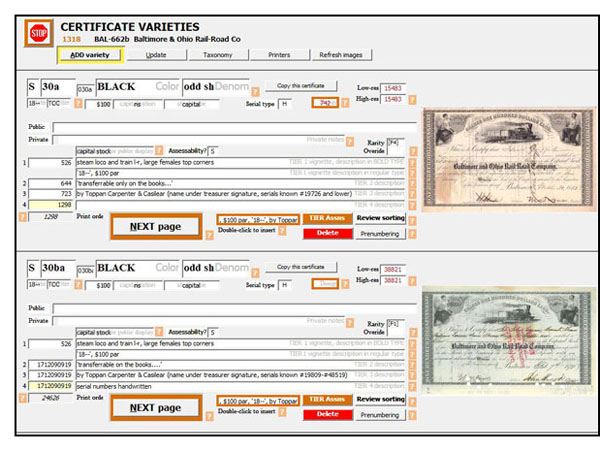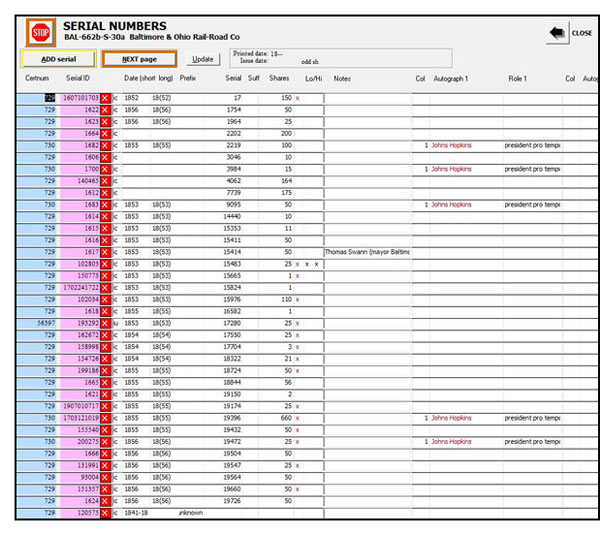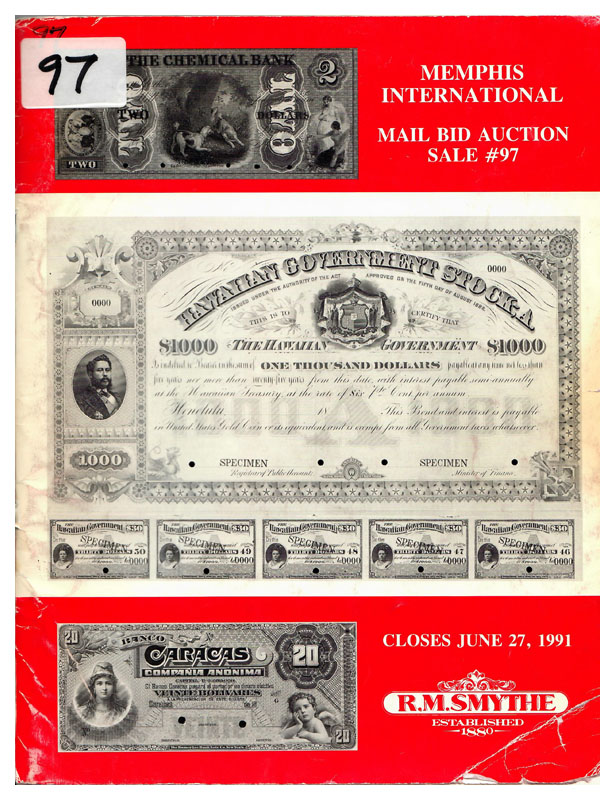Types of information recorded

Small selection of auction catalogs
Collectors often ask what kinds of information I need. If we're talking about certificates, the basic answer is almost everything. If we're talking about other kinds of information, the answer is greatly more limited.
My goal is to help collectors identify and evaluate their certificates. My goal is NOT to research and regurgitate the history of every railroad that laid rail – or planned to lay rail – in North America. Rather, I the principal type of information collected involves:
- certificate identification, and
- certificate valuation.
Working under the unyielding limitation of available time, I collect any information that relates to
- certificate varieties,
- important certificate sub-varieties,
- features that affect how collectors value or devalue certificates, and
- serial numbers so collectors can make their own estimates of scarcity.
General information recorded about companies
- Name. I try to list company names exactly as they appear on official documents. Spelling on certificates takes precedence. Railroad companies re-incorporated and merged frequently, so certificates are attributed to different incorporations when possible.
- Start-up dates. Incorporation dates in primary states take precedence.
- Dissolution dates. Dates of sheriffs' sales take precedence in cases of bankruptcy
- State(s) of incorporation. State names on certificates take precedence over published sources no matter how official those sources might be. State names can be printed on certificates, embossed or imprinted on corporate seals or can otherwise be determined by state seals or coats of arms.
- Short corporate histories. Usually contributed by collectors, histories can be up to four paragraphs in length and must be focused on single company names. Lengths of histories must be commensurate with importance of companies. It makes no sense to write a four-paragraph history about a company that lasted for a year and was a mile in length.
- Other miscellaneous information. Other information is occasionally recorded if potentially important to the hobby of collecting certificates.
Information recorded about certificates
-

Database form for entering certificate information
All Certificates
- Certificate type (stock, bond, other). Only items related directly to the ownership of securities are recorded. Details about dissociated parts of certificates (coupons, stubs, letters, etc.) are not recorded.
- Color of border (and underprint color if different).
- Description of primary vignette.
- Description of secondary features are recorded when necessary to discriminate between closely similar certificates. This includes secondary vignettes, underprints, overprints, locations of features, type style, title style, stamp frames. etc.
- Printing/engraving company name.
- Imprinted revenues. Imprints are described by "RN" numbers that as described in Scott Specialized Catalogue of United States Stamps and Covers. Foreign revenue imprints are ignored.
- Stock certificates
- Sub-type (common, preferred, capital, ordinary, etc.).
- Printed denomination (<100 sh, 50 sh, etc.).
- Par value.
- Capitalization value.
- Printed portion of date
- Voting trust certificates. These look like stock certificates and share many common features. They are considered stock certificates for cataloging purposes.
- Bonds
- Sub-type (1st mortgage, consolidated mortgage, etc).
- Series number or letter (if present).
- Registration type (bearer coupon vs. registered).
- Denomination ($odd, $500, $1000, etc).
- Interest rate.
- Redemption or due date.
- Issuance date.
- Printed portion of date (on registered bonds).
- Bond term in years.
- Authorized loan amount.
-

Database form for entering serial number information
Equipment trusts. Although often worded like stock certificates, equipment trusts closely resemble ordinary bonds in appearance and purpose. They are considered bonds for cataloging purposes.
- Other certificates (certificates other than stocks and bonds.)
- Sub-type (scrip, transfers, receipts, etc.).
- Printed portion of date.
- Denomination.
- Purpose.
Specific information recorded about individual certificates
- Issue date.
- Issuance condition (issued, unissued, specimen, proof)
- Cancellation condition (cancelled, uncancelled)
- Serial number (including letters, leading zeros, prefix and suffix characters).
- Celebrity autograph (if present.)
- Celebrity role (president, stockholder, trustee, etc.)
- Source name (names of collector, auction house, dealer, website, etc.)
- Reference number (auction lot number).
- Date information acquired (contribution date, sale date, catalog date, etc.)
- Image number.
- Sale price (if paid or sold, rounded to the nearest dollar counting commission and VAT, but not postage.)
- Start price (in formal auctions)
- Special notes (e.g., in frame, heavily damaged, water stained, torn, etc.)
Information NOT recorded about certificates
Features added to certificates after printing are
generally ignored unless those features are otherwise needed to discriminate between highly similar sub-varieties:
- Adhesive revenue stamps.
- Trust company names.
- Officer names (unless considered a celebrity)
- Stockholder or bondholder names (unless considered a celebrity)
- Types of corporate seal (unless known in multiple forms)
- Cancellation types (punch, pinhole, rubber stamp, etc.).
- Cancellation dates.
- Handwritten notes in margins or on backs.
Sources of information
I argue that not ALL information is valuable. For instance, information that is too vague creates a significant risk of causing cause confusion and mistakes. Consequently, I handle information from different sources differently

NASCA / RM Smythe auction 97 (1990)
- Collectors. Collectors are usually my best sources of information. If they send copies or scans of certificates, they give me the ability to go back and reexamine certificates at any time in the future. That allows me to uncover sub-varieties at any future time. Moreover, copies and scans allow me to record almost every bit of information available. I always appreciate it when collectors tell me their purchase prices. Sadly, I often need to ignore contributed information that lacks accompanying images. Contributions like spreadsheets are well-meaning, but require more time to extract information than images without allowing any ability to check for accuracy. These days, almost everyone has the ability to take photographs of their certificates with smart phones.
- Auction catalogs. Illustrated catalogs are extremely helpful because they give me the ability to go back several decades to acquire and reexamine information. Catalogs that list serial numbers and dates are the most valuable, provided there is sufficient information to determine which variety is being offered for sale. Over time, I have realized that catalogs that failed to show illustrations created more problems than they solved because I they created too many errors guessing which varieties might have been sold. I decided several years ago to abandon retrieving information from unillustrated catalogs, lists and spreadsheets.
- Dealer lists. Most dealers issued printed lists and catalogs when I started this project. Most were not illustrated, I still was able to acquire tremendous numbers of genuine prices. These days, printed lists have been replaced almost entirely by online web inventories. Thankfully, most of those web inventories are illustrated, although I typically cannot acquire serial numbers because images are too small. Dealer prices remain highly valuable.
- eBay offerings. eBay auctions often represent near-wholesale prices and they tend to represent a repetitive selection of available certificates. Nonetheless, eBay offerings are highly valuable because every lot is illustrated. eBay has increased its acceptable image sizes to the point where serial numbers are usually visible. One of the greatest downsides is the sheer number of offerings. Because this is a one-man project, there are simply too many offerings for me to deal with. I therefore limit my data gathering to only those lots that actually sell for more than $19.50 (which rounds to $20.) I do NOT list certificates until they sell although I occasionally make exceptions for super-rare certificates listed for absurdly high prices that stand no chance of selling, Because I acquire eBay sale prices every day, I ask contributors NOT to send links to eBay sales.